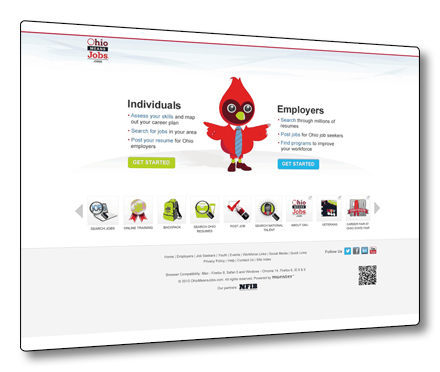
As published in the September 1, 2013 Toledo Business Journal

Tracy Intihar
Governor’s Office of Workforce Transformation
Workforce development: A strategic priority
Toledo Business Journal recently interviewed Tracy Intihar. Intihar is the director of the Governor’s Office of Workforce Transformation having been appointed at the creation of this entity in 2012.
Toledo Business Journal: A set of strategic priorities was established when the Office of Workforce Transformation was created in 2012. One of the priorities was to identify the most urgent needs of businesses in Ohio. Can you update progress in this area?
Tracy Intihar: Identifying and summarizing businesses’ workforce needs has become the foundation for much of our workforce reform work. We believe that to better understand the problems and influence change, we need to aggregate the workforce needs of an industry. The current system and practice supports “one-off solutions” for business, typically working with an education provider or the local workforce system. We believe we can expand the talent pipeline of workers for employers more efficiently by addressing the workforce needs of an industry.
Our work to identify and summarize the needs of business includes three important data sources: 1) current State jobs data collected to meet federal requirements, 2) data summarized from OhioMeansJobs, Ohio’s online matching tool, tracks company postings to identify trends and shortages, and 3) a survey tool sent to 2,000 of Ohio’s top businesses in priority industry clusters.
Ohio is prepared to provide a summary of in-demand jobs for the state, by region and industry in early 2014, and in a four-county (Lucas, Clark, Belmont, and Stark) pilot in September. We will make the information available on OhioMeansJobs.com to provide information to students and job changers about the best opportunities. We also want to use the information to create dialogue in industries with the most urgent shortages to better understand the gaps in the system and to make a plan to address the gaps.
TBJ: Another strategic priority is to align the skills needs of employers with the training offerings of the education system in Ohio. Can you update progress in this area?
Intihar: To better align the skills needs of employers with the education and training system, the state is focused on two opportunities.
First, with a good summary of our most urgent job needs, we believe industry dialogue to understand the gaps in the education and workforce system is the best opportunity to influence change. As an example of a successful sector partnership, insurance industry leaders of Ohio’s largest companies identified their needs and, after a thoughtful gap analysis, created an action plan of short- and long-term objectives. They worked with a number of higher education schools to start up new insurance programs and to tweak curricula of existing education programs.
They also realized they had a marketing challenge. They needed more students interested in the insurance industry. They pooled their own resources for a marketing campaign to increase the number of people interested in their programs.
The Governor’s Office of Workforce Transformation (OWT) is developing strategies to create additional industry sector partnerships and give partnerships already under way the tools they need to succeed.
We are also partnering with the Ohio Department of Education to build opportunities at the K-12 level to expose students to career pathways earlier in school and to receive additional support and tools to help them understand career options available to them.
TBJ: The third strategic priority is to reform Ohio’s fragmented workforce delivery system. Can you update efforts in this area?
Intihar: To date, the State has approximately 90 workforce programs in 13 State agencies. OWT is focused on reforming the programs to make common sense updates to the program and policies to ensure better connections between business and workers.
A common complaint from business and people who rely on the workforce system is that it is fragmented, confusing, and misaligned. OWT and the Governor’s Executive Workforce Board, our advisory board, are committed to improving the system. Considering some of the most basic workforce criteria based on common sense, we are streamlining and improving our workforce programs:
- Is the program focused on business’ needs?
- Is the program simple and easy to access?
- Does the program support training for in-demand jobs?
TBJ: Can you explain the Ohio Workforce Coalition and the Workforce Advisory Board and their relationship to your organization, Office of Workforce Transformation?
Intihar: Governor Kasich created the Office of Workforce Transformation in February 2012 to provide a focus on transforming Ohio’s workforce system. He also appointed the Governor’s Executive Workforce Board to advise and guide our work. The Board is comprised of representatives of private-industry business, representatives of local government, labor, education, and the Ohio General Assembly. The three priorities of the board include the following: 1) forecast the needs of business, 2) streamline delivery and services of workforce programs, 3) implement performance measures for the workforce system.
The Ohio Workforce Coalition is a private group that formed in 2004 and is comprised of education and training institutions, economic and workforce development organizations, business and industry, labor, and human services providers. They work to promote reforms to strengthen workforce reforms. We collaborate with representatives from the coalition on a number of important reforms, most significantly, the sector partnership proposal.
TBJ: Can you discuss the Industry Sector Partnerships initiative and its role in workforce development?
Intihar: We are really excited about industry sector partnerships to put a forecast to work in addressing critical shortages. We believe sector partnerships have been established as a best practice in workforce development circles, not only in Ohio but across the country. The value of the partnership is to have an industry-led dialogue to begin to address the challenges businesses face in finding the workers they need. Data regarding workforce shortages takes us only so far in our workforce reform work. A sector partnership allows an industry to work collaboratively with education and training partners, local workforce, unions, and other workforce partners to make changes to grow the talent pipeline.
TBJ: Can you discuss the role of the Local Workforce Investment Boards in Ohio?
Intihar: Local Workforce Investment Boards (WIBs) are important partners in our workforce transformation work. Local WIBs are the support entity for many individuals struggling to find work. They need to become a more important resource for businesses challenged with workforce shortages.
Some of the key OWT initiatives involving local WIBs include their participation in successful sector partnerships. We are also working with our WIB partners on creating aligned performance measures – creating a common set of simple workforce measures for all of our workforce programs – to better understand what works and what does not. Aligned performance metrics would potentially measure and report in these key areas: connection to a job (both short- and long-term employment); earnings; access to an industry-recognized credential; and business engagement. Applying simple workforce measures at the local One-Stop level will be an important opportunity to understand priorities and needs at the local workforce level.
TBJ: Can you discuss the initiative involving One-Stop shops for workforce development and branding efforts?
Intihar: In early reviews and evaluation of our current workforce system, a number of “low-hanging fruit” reforms became obvious. Rebranding our local One-Stops to create a consistent name was an obvious opportunity for both business and job seeker customers. We also saw the value of prioritizing the State’s job matching tool, OhioMeansJobs. While most local workforce systems used OhioMeansJobs, some maintained separate systems that seemed inefficient and a challenge for creating a seamless system for veterans and those on unemployment. We are excited the reforms in House Bill 1 became law. And know that this is a good first step in providing consistency at the local level.
TBJ: What role will the OhioMeansJobs system play in workforce development in the State?
Intihar: OhioMeansJobs is a great online tool that provides a benefit to both business looking for workers and people looking for a job. My office is excited about enhancements that are currently being built for OhioMeansJobs to move the tool beyond just a job matching tool to a career planning tool. Including data on the in-demand jobs in a region will allow a job seeker or a student planning next steps to see what careers present the best opportunities.

Some of the questions that OhioMeansJobs attempts to answer include:
- Where are they most likely to find a job?
- What is the average salary?
- Where are the training programs in the area?
- How long are those programs and what do they cost?
The tool enhancements will deployed in a four county pilot in September with a rollout statewide in January. We are excited about the potential to help job seekers who may not want to visit a local One-Stop. We love that the system prioritizes veterans in searches. And, we love that the “enhanced” OhioMeansJobs will show you the in-demand jobs in your area and the training programs tied to them.
TBJ: Are there any other issues that you would like to discuss?
Intihar: Workforce development is a complicated system. It is a system ripe for reform. Governor Kasich has made this area a top priority because he understands the importance of a strong workforce to the growth of Ohio’s economy.
The Office of Workforce Transformation has clear focus on three strategic priorities that will help us stay focused on achievable, worthwhile priorities:
- Identify and summarize business workforce needs
- Align these needs with education and training
- Reform our current workforce system
With clear metrics and a business-centric focus, we are making important reforms to our workforce system that will help businesses find the workers they need more easily and help workers find good careers to support their families.